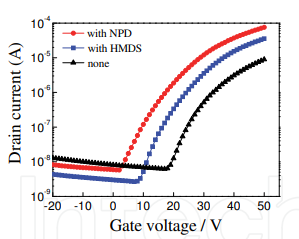In recent years, organic transistors have attracted much attention due to their advantages indeveloping low-cost, flexible, and large-area production. So far, many kinds of organicmaterials have been reported to achieve high-performance organic field-effect transistors(OFETs). There are two types of organic semiconductors, p-type and n-type, whose majoritycarriers are holes and electrons, respectively. For logic gates application, both types andsimilar performance OFETs are required for CMOS application. Pentacene is the mostpopular material in p-type OFET, and many kinds of polymer materials are also reported(McCulloch et al., 2006). On the other hand, the performance of n-type OFETs is generallyinferior to that of p-type (Dimitrakopoulos and Malenfant, 2002). In particular, stability inair is the most serious problem in n-type OFET. Fullerene is the most standard n-typematerial showing the highest mobility (Singh et al., 2007); however, the device cannotoperate in air.
There are two guidelines to achieve high mobility and high stability in n-type OFET. One isto develop a new material having deeper LUMO level. Oxygen and water deteriorate OFETperformance by accepting electrons from the semiconductor molecule. Therefore, enoughdeep LUMO level is an efficient way to avoid effect of oxygen or water. In fact, there havebeen many materials having deep LUMO levels, for example, perylene bisimide compound,fullerene derivatives, fluorinated compounds, and so on.
The other important point is surface treatment of the insulator. The field-effect mobility ofthe organic semiconductor is strongly affected by the device fabrication process. Variousmethods on surface treatments have been reported to improve the carrier mobility. TheHMDS treatment is a standard and efficient way to make the surface hydrophobic (Lin et al.,1997; Lim et al., 2005). Organic semiconductor can aggregate with high crystallinity on thehydrophobic surface without influence of the substrate surface. These methods weredeveloped in p-type OFETs; however, they are also efficient to improve the mobility andstability of n-type OFETs. Recently, it has been pointed out that low mobility and instabilityin air of n-type organic semiconductor is attributed to the surface electron traps of the gateinsulator, and if electron traps can be perfectly eliminated, almost organic semiconductorscan be operate in n-type mode (Chua et al., 2005). Therefore, it has been believed that thegate insulator surface should be as possible as inert to achieve high mobility and stability inn-type OFETs.

Fig1
These results indicate that an electronically active material can be used to fabricate aninterfacial layer, and high performance can be achieved without a surface treatment of selfassembly monolayer. We also investigated some other organic materials, n-hexatriacontanethat is perfectly inert material, and Alq3 that is a well-known emissive and electrontransporting material. In these cases, the mobility was rather reduced to be 10–3 cm2/Vs.These results enable us to conclude that hole transporting materials are responsible forenhancing mobility.
上一篇: 旋涂法沉积氧化铝薄膜c硅片表面钝化